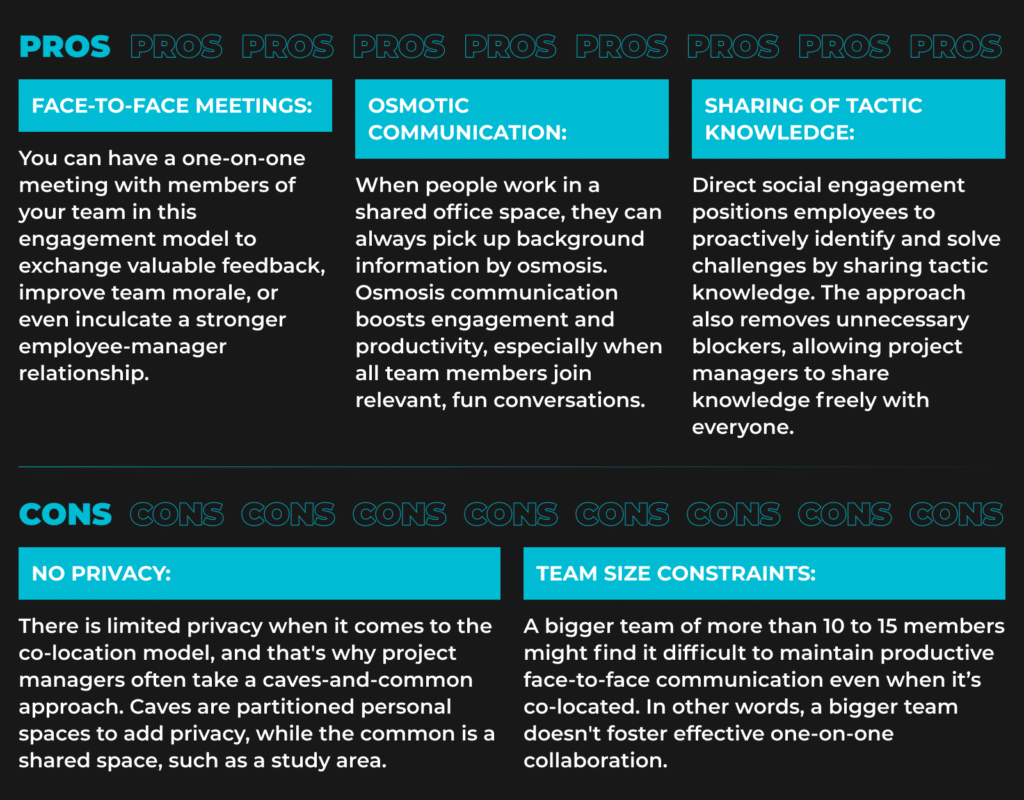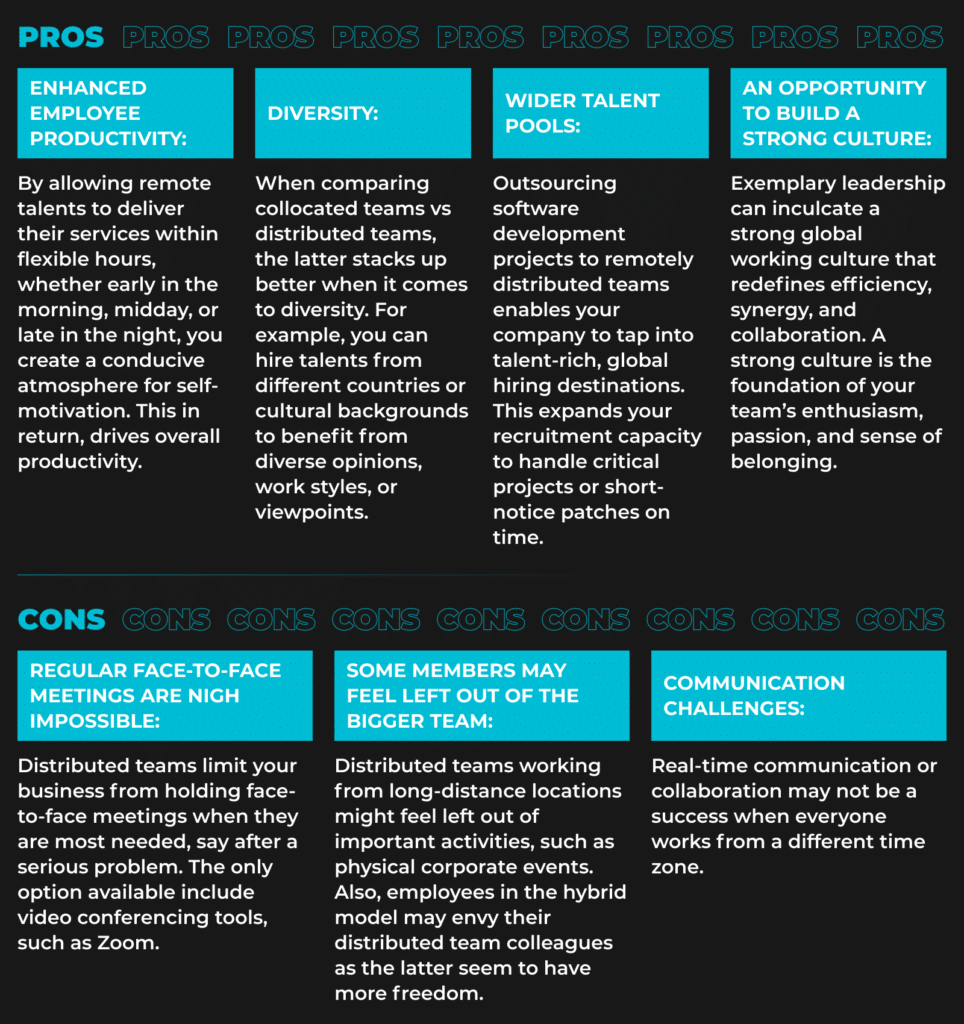Co-located vs. Distributed Teams: Difference and Benefits for Business
To increase visibility, adaptability, and product quality in software development, 71% of companies in the US have adopted agile methodology and associated frameworks like Scrum. Depending on an organization’s hiring or project implementation needs, an agile team can either be distributed or co-located.

But the real question is, what are the risk-benefits of distributed vs co located agile teams? In this article, we describe the pros and cons of co-location versus distributed teams, as well as tips to help you choose the better option. We also highlight when organizations prefer either of the two engagement models.
Co-Located Teams Pros and Cons for Startups and R-n-D Centres
In a typical co-located engagement model, employees work in a shared space. In other words, everyone works in the same geographical location, whether on-site or from a remote hiring destination. Co-located teams can either operate from single or multiple sites.
But like any other collaboration method, the co-located approach has its share of advantages and disadvantages.

Distributed Teams Pros and Cons for Software Startups and R-n-D Centres
In distributed teams, as the name suggests, all developers are physically located away from each other and often operate in different time zones. The members of a distributed team can be working from home, in global co-working spaces, or even in coffee shops, but outside the proximity of their colleagues.
This engagement model is popular thanks to its numerous benefits that some businesses have found to outweigh the drawbacks. For example, 63% of HR and 57% of IT departments report having virtual distributed teams.

…
I’m ready to hire a dedicated team
Book a call
…
When Do Businesses Prefer Co-Location or Distributed Teams?
Now that you understand the pros and cons of co location versus distributed team management, when should you prefer either of the engagement models for software development? Co-location is ideal if you want to take an agile approach because bringing the team together under one building fosters creativity and “think together” sessions. Moreover, zero physical barriers enhance one-on-one communication with visualizations, ensuring everyone is on the same page. This level of access and control also makes the model excellent for sensitive projects.
On the other hand, distributed teams are optimal for organizations that want to scale in terms of production or market reach, as they are an avenue to overseas job and consumer markets. This model allows you to hire expert talents at relatively affordable rates and save the costs of office space. That way, you get extra money in your budget to drive innovation and product development.
However, it’s important to understand that partnering with colocated vs distributed teams isn’t an automatic approach to agile working or heightened performance. Instead, achieving these objectives depends on whether you’re an understanding leader keen to nurture, motivate, and set the pace by example.
4 Tips on How to Choose Between Colocated vs. Distributed Teams
It can be daunting to make a decision on co-located vs distributed teams, especially if you want to engage either of the models for the first time. That said, have the following factors in mind before embarking on a journey with either:
Trust and Safety
Unquestionable trust and all-around cybersecurity awareness are the glue of global workspaces. While a co-located model enables you to evaluate whether employees meet these qualities all the time, it may be difficult to do the same with distributed teams, thanks to distance barriers. If you are not in a position to adopt technologies or strategies that bridge this virtual gap, engaging a model that you can directly control sounds like the best option.
Communication and Information Sharing
Communication and information sharing are the core components of software development, whether in co-located or distributed development teams. Businesses that have invested in next-gen digital communication tools can collaborate efficiently with distributed teams. On the other hand, if you’re partnering with co-located teams, you might need to organize your workspace using the caves-and-common approach so that employees can freely share written and tactical knowledge.
The Size of Your Business
While weighing the option of partnering with collocated vs distributed teams, it’s important to consider the size of your business, especially if you’re going to pick a model that will yield a positive ROI. If you’re a startup, consider working with a single-site co-located team, where you can control everything to minimize chaos before gradually progressing to multiple sites. On the other hand, bigger organizations can work with distributed development model because they have enough budget to hire dedicated project managers alongside distributed workers.
Which Work Culture Do You Want to Identify With?
According to the latest statistics, 16% of companies identify themselves as fully remote. And across the globe, more businesses are embracing a hybrid work model, where employees partially work remotely and commute to the office. The point is different companies have varying cultures that help them retain workers and enhance employee experience. Do thorough research on co location versus distributed teams to determine which one is flexible and aligns with the culture you want to promote.
Newxel’s Experience in Recruiting Distributed and Co-Located Teams
As a full-service company, Newxel is considered a trusted partner for distributed and co-located teams across all industries. Our years of experience in the industry help you fill vacant IT positions in your business within 3 to 5 weeks, an approach that saves you time, money, and worries, especially with the ongoing talent shortage.
We can also hire any expert talent you need, whether a data engineer, full-stack developer, business analyst, or anyone else required to get the job done. Newxel experts scout for talents from global destinations with big specialized developer pools, like Ukraine, Poland, Bulgaria, or Hungary.
Are you convinced that a dedicated on-located team will help you bridge the competition gap?
…
Don’t dismiss the idea yet; hear what our experts think.
…
Conclusion
Both co-located and distributed teams can help you achieve various business objectives, depending on how they are managed. With this in mind, you should pick a project that serves your business needs, whether it’s agile implementation or cost reduction. Most importantly, go with a model that reveals the flaws of your current laid-back approach so that you can improve how you manage projects in the future.





